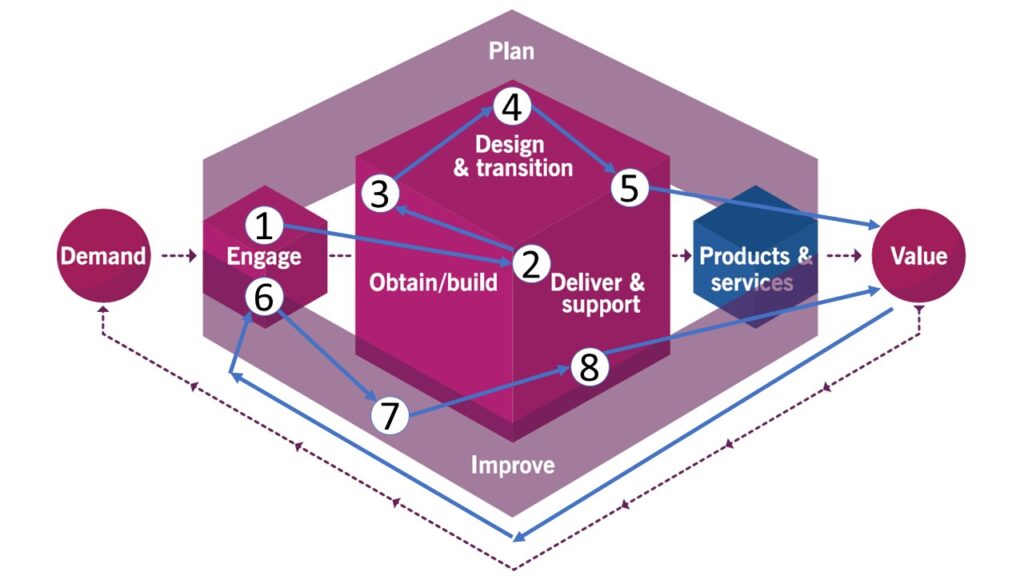
Meet our people: Dr. Plamen Ivanov
26.05.2020
Summer Team Event 2020
08.10.2020ITILv4 & ServiceNow: Friends or Foes (How to implement ITILv4 Value Streams with ServiceNow Flows)

ITILv4 Service Value Stream
We, at Noser Bulgaria, always try to enable and support organizations in their digital transformation to be able to follow the top-notch global tendencies. But what is digital transformation? It is an extensively and most often misused term that leads to a diverse, unclear, and uncommon understanding. Our definition is: “Implementation of digital technology to achieve significant improvement, e.g. technology-enabled automation that changes the way the company does its current business or enables a completely new one”.
Modern and promising methodologies and technologies must justify such a significant change. Fortunately, now we are on the doorstep of something big because of modern methodologies like ITILv4 and thrilling technologies like ServiceNow Flows.
What is new at ITIL4?
As a result of the digital transformation, we are all experiencing higher demands and more expectations on IT. Two aspects are of critical significance for each organization. The first one is to have transparency on how and what is delivering value to its stakeholders. The second one is to be able quickly to improve and adapt to the continually changing customer needs and environment changes.
To address these challenges, the latest fourth version of ITIL was introduced. Axelos (2017) acknowledged it for the first time at the end of 2017 and released the first foundation training on 28 February 2019 (Axelos, 2020). One of the key aspects is the value stream. This concept is not new to the world of service management. It represents one of the many bridges that through the ITIL4 implementation is targeted to achieve an appropriate integration with other best practices and most specifically with lean management (Andenmatten, 2020). The idea behind that term is to group logically related steps necessary for the organization to create and deliver value to its consumers by products and services (Axelos Limited, 2019). To be able to achieve that effectively and efficiently, the organization should apply the seven guiding principles and consider the four dimensions of Service Management.
A value stream always starts with demand or opportunity and end with delivering some value to stakeholders that, according to The Stationery Office (2019), could include perceived benefits, usefulness, or importance of something. An example of a value stream is presented in the following figure:

Figure 1: Customer Support Value Stream (Anand, 2019)
The value stream uses fundamental blocks named service value chain activities, which are supported by various practices that contribute and enable each one of them (Anand, 2019). These activities, part of the so-called Service Value Chain (SVC), are meant to be used to transform the demand and opportunities into outputs used by the different stakeholders enabling them to achieve their outcomes. We can apply it with the traditional waterfall approach or with the more modern agile approach, all based on company targets. And suppose we go up in the hierarchy. In that case, the SVC represents a central element of the overall architecture of the organization’s IT Service Management and core system of ITIL4 named Service Value System (SVS).
What is the relationship between ITILv4 and ServiceNow Flows?
Basically, the value stream is the exact place where the actions take place. As a result, they should be agile – easily identifiable, manageable, improved, and adjustable to the continuously changing business needs. After defining these, so-called by Wright (2020), operational workflows (as value streams are exactly such ones), the next step is to implement and adapt them by digital workflows or more trendy said: digital flows. For that, we need an appropriate tool that should support such agility plus relevant visual representation.
According to ServiceNow (2020), the flow could be used to automate different processes by a sequence of reusable actions. All flows have several standard components: a trigger (conditions that, when evaluated to true, start the flow), a series of actions (reusable logic that performs different types of activities on provided inputs and delivers specific outcomes), flow logic and the data collected or created (ServiceNow, 2020).
For flows development, ServiceNow (2020) delivers a feature called: Flow Designer. It allows value streams automation in a single design environment and integration with external instances or third-party systems through the IntegrationHub. Through the Flow Designer, there could be developed different functionalities like scheduled automation, approval processing, notifications management mechanisms, and many more. The target is to replace the legacy development functionalities like schedulers, business rules and workflows, with one centralized place for development, control, testing, and troubleshooting. To achieve this, the Flow Designer delivers the following content types:
- Flows – automated processing of a process and business logic (implementing a step approach) that can include a trigger, subflows, actions and flows logic elements
- Subflows – structures automated processing that could be applied and reused for different developments and enable improved maintenance
- Actions – a group of various reusable operations: core actions (out of the box action like Create Record, Create Tasks, Look Up Record) and customized ones (developed by developers) that extend the present ones
- Action steps – represent a single and reusable operation within an action
- Spokes – grouped and scoped application content based on an application or record type.
There are several additional features that the Flow Designer gives you and I like:
- Information integrity: access and pass information between the different actions that are part of a flow or subflow
- Data management: the capability to manipulate data (for example: to change data types from string to date/time and vice versa) with so call data pills
- Advanced testing capabilities: the ability to test the developed flow, subflow and action before publishing. You can review runtime execution information directly from the design environment (like passed input variable values, selected record, or actions execution state), identify, interpret, and troubleshoot potential issues.
Conclusion
Based on my professional opinion, Wright (2020) and ServiceNow (2020) could be highlighted several critical benefits by implementing operational value streams with digital flows (by platform feature like ServiceNow Flow Designer):
- Centralized development and execution place – increased visibility and clarity: end-to-end understanding and holistic view
- Shared and collective knowledge: improving collaboration between developers and operations
- Easy bottlenecks identification: room for optimization and automation
- Evaluation capabilities: to identify what you already have, could reuse, optimize, or automate
- Reduced development and upgrade costs: by the development of reusable actions
- Automation
- Consolidates different platform automation capabilities into a single environment: optimized integration capabilities
References:
Anand, A. (2019) ITIL 4: Connecting key concepts – Part 4. [online]. Available from: https://www.axelos.com/news/blogs/may-2019/itil-4-connecting-key-concepts-part-4 [Accessed 12st June 2020].
Andenmatten, M. (2020) Agile Service Management – From Processes to Value Streams. [online]. Available from: https://www.axelos.com/news/blogs/community-blog-posts/agile-service-management-from-processes-to-value [Accessed 12st June 2020].
Axelos. (2017) ITIL® Update. [online]. Available from: https://www.axelos.com/itil-update [Accessed 21st May 2020].
Axelos. (2020) ITIL 4 Frequently Asked Questions (FAQs). [online]. Available from: https://www.axelos.com/getmedia/7afddf17-aaa6-410d-bc00-4d8358aecc10/ITIL-4-public-FAQs.aspx [Accessed 21st May 2020].
Axelos Limited. (2019) ITIL Foundation ITIL 4 edition Glossary. [online]. Available from: https://purplegriffon.com/downloads/resources/itil4-foundation-glossary-january-2019.pdf [Accessed 13st June 2020].
ServiceNow. (2020) Flows. [online]. Available from: https://docs.servicenow.com/bundle/orlando-servicenow-platform/page/administer/flow-designer/concept/flows.html [Accessed 21st July 2020].
ServiceNow. (2020) Flow Designer. [online]. Available from: https://docs.servicenow.com/bundle/orlando-servicenow-platform/page/administer/flow-designer/concept/flow-designer.html [Accessed 21st July 2020].
The Stationery Office. (2019) ITIL Foundation, ITIL 4th Edition. Axelos.
Wright, D. (2020) Rethinking Knowledge Work In A Post-Pandemic World. [online]. Forbes. Available from: https://www.forbes.com/sites/servicenow/2020/07/07/rethinking-knowledge-work-in-a-post-pandemic-world/#7299a221abf5 [Accessed 21st July 2020].

